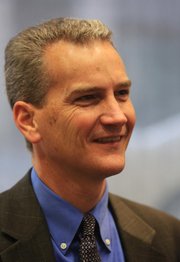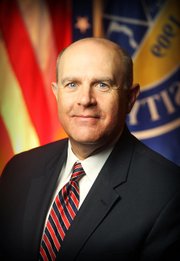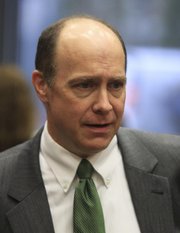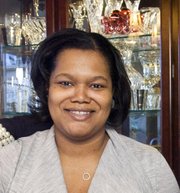Enrollment at the state's public and private colleges and universities is down this fall by less than 1 percent, according to the Arkansas Department of Higher Education.
The state recorded some 167,406 students at all public and private higher-education institutions, a slight drop from last fall's 168,621 students, department data show.
The 0.7 percent decrease isn't what the state's higher-education leaders were hoping for after a push earlier this month from Gov. Asa Hutchinson to increase college completion rates.
"Some decline in community college enrollments naturally occurs as economic trends and job prospects improve," Higher Education Department Director Brett Powell said in a prepared statement.
"On the other hand, we know that many Arkansans are unprepared for the jobs of tomorrow so we hope to reverse this trend in coming years by reaching out to adults without any postsecondary credentials and students coming out of high school who typically enroll in higher education at lower rates."
Committees working on the state's master higher-education plan are focusing on getting more adult Arkansans and underserved student populations -- such as low-income and minority groups -- to earn postsecondary credentials, Powell said Tuesday. The committees are looking at ways to redesign educational programs, mirroring Hutchinson's goals.
The goal of the master plan is to increase enrollment and students' college completion rates, he said. The Higher Education Department is hoping to have a plan for the Arkansas Higher Education Coordinating Board to review at its Oct. 30 meeting.
This fall, the state's public four-year universities saw a 1.6 percent average overall increase from 97,977 to 99,570 students, while the average overall percentage for community colleges dropped 5.4 percent from 53,377 to 50,497 students.
Private and independent colleges, meanwhile, had an average increase of less than 1 percent, to 16,618 students enrolled compared from 16,461 last year.
Of the four-year universities, the University of Arkansas at Fayetteville had a 2 percent increase to a record 26,754 students from last year's 26,237.
Flagship campuses in neighboring states also saw increases, with Oklahoma University in Norman registering a 1.5 percent bump at 27,445 students and with Louisiana State University in Baton Rouge recording a 2 percent jump to 31,527 students. The University of Texas at Austin had a slight decrease of less than 1 percent, with 50,972 students this fall.
In Arkansas, the university with the biggest jump was Southern Arkansas University. The Magnolia university set records this year with a 16.7 percent enrollment increase at 4,138 students from 3,546 students last year.
"A lot of things that we've been working on came together," SAU President Trey Berry said. "I think what's happened is over the past several years, we've created some unique and dynamic academic programs that are attracting students all over the world and definitely around the country."
The university started an engineering program in fall 2013 with 60 students, and that number has doubled this fall. SAU is also in its third year offering a game development and animation design program, one that Berry said attracts students nationwide.
Officials there also tried "some new and innovative recruitment techniques," including advertisements on Pandora, the online music streaming service, and a partnership with a Texarkana water park to offer free admission to 14- to 18-year-olds if they filled out an information sheet for the university.
SAU saw growth in its graduate programs, many of which are online, and had a large jump in international students, in part because of word of mouth, Berry said. Most of the international students from India, Nepal, Saudi Arabia and China are interested in the masters programs in business and computer science, he said.
The enrollment spark, Berry said, means the university will have to re-evaluate the institution.
"Do we have adequate facilities?" he asked. "Do we have adequate personnel? Do we have adequate programs to make this an atmosphere that's conducive and really happy for these students?
"We don't want to get caught in a trap of growing numbers for growing numbers. We want this to be a quality growth."
Other schools saw smaller increases, up to about 6 percent.
Only three had slips: Henderson State University in Arkadelphia, with a 2.6 percent drop from 3,625 students to 3,530; the University of Arkansas at Fort Smith, with a 1.6 percent drop from 6,823 students to 6,713; and the University of Arkansas at Monticello, with a 5.1 percent drop from 3,854 students to 3,659.
UA-Monticello interim Chancellor Jay Jones said the biggest decline there -- some 90 percent -- came from entering freshmen, which he attributed in part to declining population in southeast Arkansas. Of that group, Jones said the school was losing a number of students seeking associate's degrees.
The university, which admits all students with a high school diploma or a GED, is trying to expand its reach beyond the region by increasing advertisements in Northwest and central Arkansas, he said. It also hired a recruiting coordinator just for its Forestry and Natural Resources program.
UA-Monticello, which has been battling retention problems, is also working on that aspect. The school was at risk of losing about $182,000 in state funding based on certain performance measures, but earned back the money after the Higher Education Department approved a retention plan.
Part of that plan includes hiring an institutional research officer to identify students likely to drop out, as well as evaluating programs and looking at potential new ones, Jones said. The university is planning to bring to the Higher Education Coordinating Board a proposal for an associate's degree in diesel training, he said, and Monticello staff members are discussing other degree options.
Of the two-year colleges, Northwest Arkansas Community College surpassed Pulaski Technical College as the state's largest this year. The college, which budgeted for a 3 percent decrease in students, saw a 4.8 percent drop to 7,709 students, according to a news release. Last year's enrollment was 8,098.
"College leadership made a concerted effort to budget conservatively when planning for the 2015-16 academic year, knowing that community colleges nationwide have been experiencing a decrease," Steven R. Hinds, Northwest Arkansas Community College's executive director of public relations and marketing, said in a news release.
Unlike four-year institutions, community colleges typically see enrollment increases when the economy sinks and the unemployment rate rises. Two-year institutions experience the opposite when the economy recovers.
Pulaski Tech had the biggest decline among the state's community colleges at 17.2 percent. It recorded 7,648 students for fall 2015 but had 9,236 in fall 2014.
The Little Rock college has attributed part of the drop to its implementation of minimum reading scores as an admission requirement. The college -- which used to be an open-admissions school accepting all students with a high school diploma or GED -- changed to set a minimum reading score level of 13 on the ACT college admissions exam, a 62 on the COMPASS and a 35 on the ASSET placement tests.
Pulaski Tech also partners with Literacy Action of Central Arkansas, which allows students or potential students who don't score the required score on the COMPASS placement exam to take part in their free program. Students who finish the program can retake the COMPASS test and could raise their scores for admission.
Of Pulaski Tech's fall 2015 enrollment, 60 percent are enrolled in the university-transfer curriculum, meaning they plan to continue education at a four-year university. Thirty percent are enrolled in technical and occupational programs, the college said.
"We'll continue to focus on recruiting traditional age students, as well as increasing the enrollment of our adult students in the 25 and up category," said Tracy Courage, Pulaski Tech's spokesman. "Retention and graduation of our current students are the priorities."
Among Arkansas' private institutions, two open-enrollment colleges saw the biggest increase and the biggest decrease.
Arkansas Baptist College in Little Rock had a 13.2 percent increase with 968 students this fall, one of the highest recorded percentages, said LaCresha Newton, the college's chief of staff. Last year's enrollment was 855.
About half of the students are from Arkansas, while others hail from Louisiana, Michigan and Illinois, she said. The college's religious affiliation helps it recruit from out-of-state, she said.
The college recorded the enrollment increase despite being in jeopardy of losing its accreditation from the Higher Learning Commission. The commission has cited financial and leadership problems, but the college has said a $30 million federal loan has helped it make significant progress.
Arkansas Baptist recently hired a chief academic officer, Howard Gibson, to assess the college's current programming and what degree programs it could offer, Newton said.
Shorter College in North Little Rock saw a drop of more than 40 percent of its students. The college tallied 236 students this fall compared with last year's 406, department data show.
The private two-year college's president, Jerome Green, said the drop was intentional.
"We declined enrollment for approximately 71 students who enrolled in the spring and approximately another 70 to 80 from the previous semester," Green said, adding it was because of poor academic performance.
"We are an open-enrollment institution. We don't require a high [grade-point average] or ACT score to get in. But easy-in does not mean easy-out. It's a real college that has the same standards as other colleges in the state."
The college lost its accreditation in 1998 and regained another one for religious schools in 2012, when Green was picked to lead it. The college opened its doors that fall to 50 students, but the number gradually grew to about 400, he said, adding he expects the numbers to eventually soar back into the 400s.
The difference, Green said, is that this year, the college has federal funds to hire life coaches and tutors.
"A lot of times, a student does not do well because they don't make good decisions because of the environment they came from ... or they bring their problems from home with them," he said. "So this year, we expect to put on staff at least five life coaches."
The students will have an assigned coach and check in periodically.
"We are demanding performance, but we also putting in some measures to help them make that performance," he said.
Metro on 09/30/2015





